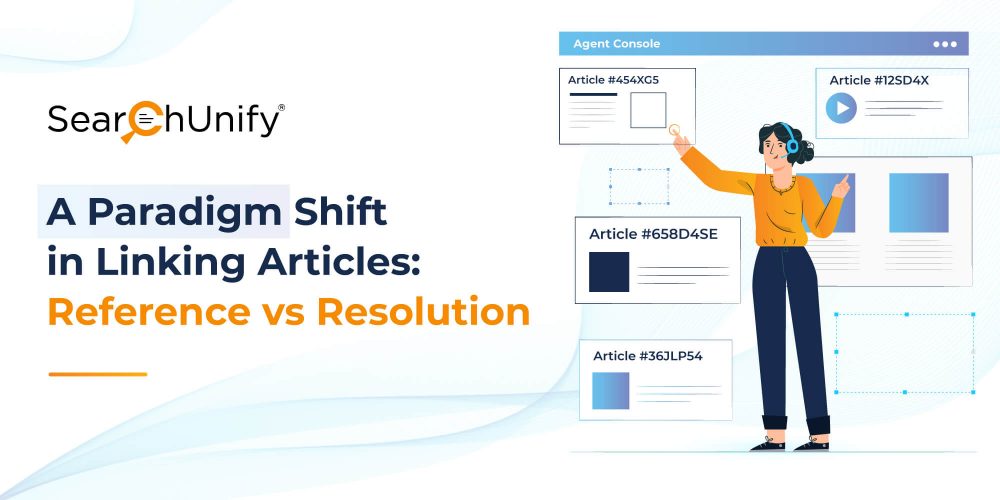
Knowledge is power. This adage especially holds ground for support teams. Agents can deliver value from the get-go only if they have access to customer insights and relevant help content. This is where Knowledge-Centered Service (KCS) comes into play. Evolving the available information into organizational knowledge that is useful, reusable, and adds value for both customers and agents alike is the essence of KCS.
The primary step for getting started in your KCS journey is capturing the collective experience present across the firm in the form of articles. This documented information is then reused and disseminated to solve similar issues that might arise in the not-so-distant future. With each reuse, the article is improved for better readability and searchability.
But, can a single resource or article be enough to solve a case? Probably only for a select few agents who get lucky. The others have to rummage through multiple articles in search of a resolution. So, how do agents get out of the murky waters of scouting information? This issue can be subdued by attaching articles with similar articles through hyperlinks.
Why is it Important to ‘Link’ Other Articles for KCS Success?
The ‘Reuse’ stage is a crucial component of the KCS strategy. This is because the future value we derive from a knowledge article can multiply significantly in terms of knowledge workers’ speed, capacity, and consistency to provide resolutions. But this behavior of reuse only creates value if the article provides the right information or insights that a knowledge worker has been scouting for. This is where the need to attach a system of record arises.
The system of record could be anything from an email, case, incident to a community thread, or a tweet that ultimately leads to a resolution. Once the source has been attached to the article, knowledge workers can also identify the re-usage patterns and how each new case has been solved by taking into account similar historic cases listed in the knowledge base.
That said, how do we know the true value of a knowledge base? Well, we must consider both — articles with the resolution along with the collective knowledge of an organization. Here, the collective knowledge is used for ‘references,’ and the article with the specific answer is used for ‘resolutions’. To hone the reuse pattern of reference and resolution articles, knowledge workers must first understand their significance and distinctiveness.
What is the Difference Between Reference and Resolution Articles?
When KCS articles provide a direct and lucid solution to the problem in a trice, they are resolutions. On the other hand, when an article is helpful and alludes to a solution, it is known as a reference.
Resolution Articles Vs. Reference Articles
| Basis of Distinction | Resolution Article | Reference Article |
|---|---|---|
|
Provides Precise Guidelines |
Yes |
No |
|
Suggests Exact Product Improvements |
Yes |
No |
|
Value Addition |
Yes |
Yes |
Since the KCS solve-evolve loop is all about creating new articles or reusing existing ones based on the specifics of the incident, it only makes sense if agents close their tickets using resolution articles. However, that’s not always the case.
No matter how much we try, there will always be tickets that are closed using references. While references are immensely convenient to use, they only act as a stepping stone towards reaching the correct resolution article, thus taking a toll on the resolution time. So, now’s the time to choose resolutions over references and move on to better linking practices.
Shift the Balance of Your KCS Teeter-Totter Towards Resolutions
If you find yourself closing most cases using reference articles, now is the time to take the plunge and shift the weight towards resolution linking to ensure KCS success. Wondering how? Given below are a few sure-fire ways that’ll come in handy:
- Link Accuracy: The solve and evolve loop are interdependent, where each loop generates knowledge by taking into consideration various articles at different levels. So, it’s always helpful to attach the articles that were used as a reference through the knowledge worker’s journey of solving a ticket. That said, it’s even more important for the knowledge worker to attach the resolution article that finally helped them to reach a satisfactory resolution.
- Disoriented Resolutions: People are confusing: but have you ever come across an article that you thought could put an end to your woes but instead confused you even more? If yes, chances are you stumbled upon reference articles that happen to be vague and nonspecific. To avoid any confusion, your contributors should step up and create resolution articles that focus on a single problem and its resolution. On the contrary, reference articles hoard a collection of approaches in the same article, thus leaving the agents perplexed.
- Pseudo Documentation: Although product documentation and knowledge base contain similar information, one key differentiator is their purpose. Documentation is built around a product’s functionality, whereas a KB is centered around customer queries. In order to shift the balance towards resolutions, a strong emphasis must be laid on cases that the support team is working on and extra bits (like product capabilities) can be left out.
- Quality Link Building: If the goal of a team is inclined towards link rates, unfortunately, the quantity of links will take precedence over quality. In a bid to save time and effort, agents often take the easy route and link as many reference articles as possible. That’s because the pieces with maximum links used to rank higher. However, things have started to change. These days, search engines recognize relevance, intent, and link patterns, thus making it all the more important to focus on quality over quantity. All said and done, the aim should be on attaching links that are helpful and resourceful. In such scenarios, resolution articles fit the bill perfectly.
The Bottomline
Knowledge workers should be advised to classify each link from an article as either a resolution or a reference to drive better support outcomes. Once this is out of the way, most kinks would get ironed out, and your agents can be well on their way to drive maximum value from KBs.
However, if you’re still struggling to tackle the information chaos at your workplace, then this E-Book comes in handy. It sheds light on the right tools that can turn the tables around to place the right information in the hands of your employees just when they need it. Happy reading!



















